Many say that the Second Boer War was the first of the modern era. They will site the use of magazine rifles, the machine gun and trenches. Unfortunately that is not quite true. The Spanish American War of 1898 precedes the events of the Boer War by more than a year. Trench warfare in some form has been around since man started beating each other with stones. The machine gun can be debated as far back as the American Civil War depending on your definition. Dr. Gatling was making a machine to make war so terrible we would stop (like that’s going to work!). One turn of the crank handle would send multiple rounds downrange from a number of the Gatling Gun’s multiple barrels. One can say it was a machine gun. However, the common definition requires a single pull of the trigger to send multiple rounds down range from a single barrel. Both these weapons were used in the Span-Am War (Gatlings and Colt M1895 Machine Guns). Also seeing action were Mauser and Krag magazine rifles with high velocity, small caliber, smokeless cartridges. So the Second Boer War was the second war of the modern era. But in neither case did the generals learn enough to keep from making the horrendous blunders of the Great War where thousands of men were sent against entrenched machine guns across open fields.
The arms carried by the Boers were somewhat varied. Their small arms were quite modern and it had a huge impact on the opening days of the war. Over the course of several years the tension between the independent Boer governments and the “outlanders” who immigrated to their lands kept growing. By the time of Jameson’s Raid (funded by Cecil Rhodes) there was little doubt that the Boers must be ready for a possible push by the British into the gold fields of the Transvaal. Therefore, the Boers started buying modern weapons.
At the start of hostilities (the Boer invasion of Natal) the Boer Burgher was fairly well equipped. He was required to bring a horse, saddle, rifle, ammunition and food for eight days upon mobilization. The Boer government distributed large numbers of smokeless powder magazine rifles to the Burghers (citizens) for their use. They were a combination of weapons including Mauser carbines, Krags (both of which were magazine rifles) and Martini- Henry single shot rifles that had been converted to smokeless powder. The trouble with this system was that while well-armed each type rifle used a different caliber of ammunition. This created a resupply problem, especially once the war actually started. The Boers were also armed with a large variety of pistols. While the Mauser auto-loading pistol with ten round box magazine was popular, they were in short supply and everything from Colt Single Action Army revolvers to Webleys to Smith and Wessons and a variety of European weapons were in use, again, each in it’s own caliber. Later in the war, as ammunition resupply became a greater and greater problem the commandos used captured British weapons extensively
The British used a combination of small arms also but had the advantage of most rifles being in a single caliber, i.e., .303. This was true for both colonial troops as well as those coming from Great Britain. One finds the Empire forces using Martini-Henry rifles and carbines, Lee-Metford and Lee-Enfield carbines and rifles. The latter two being rifles with ten round magazines. The carbines generally had five or six round magazines depending on type. While the pistol situation was slightly better among the Empire forces there was also quite a variation. Webleys, Smiths, Colts and Mausers were all used to some extent.
British & Boer Weapons
Lee-Metford and Lee-Enfield Rifles
1886 had seen the invention of smokeless powder by the French. It changed everything! Smokeless powder not only eliminated the clouds of white smoke produced by Black Powder, it increased muzzle velocities and made small caliber long range weapons possible. No longer would the soldier be limited to a close range battle where the smoke obscured his target and gave away his position. He could now engage the enemy at distances up to 800 or even 1000 yards.
In 1888 the British adopted the bolt action, magazine fed Lee-Metford rifle. The rifle was a great success (there were growing pains like any new system). In 1895 they converted to the Lee-Enfield rifle. The major difference between the two rifles was the barrel, but that change increased both range and accuracy. The effective range of the rifle was now 500 to 800 yards. (Effective range means the average shooter can hit a human target 50% of the time at that range.) This was a great advantage but also a disadvantage. It means a soldier can kill at a much greater range. (Old infantry adage: If the enemy is within range – so are you!)
New Zealand Martini-Henry Carbine
Carbines came in different variations of Martini-Henrys and Lee-Enfields. Carbines were issued to cavalry, lancers and in some cases to mounted rifles. Most mounted rifles, however, continued to carry their full size rifle. The advantage of the carbine was less weight and easier to use from a horse. The disadvantage was a decrease in muzzle velocity meaning less range and accuracy.
Lee-Enfield Carbine
Above is a Lee-Enfield carbine, note the smaller five round magazine compared to the ten round magazine of the rifles. Also the bolt handle knob is flattened and the upper hand guard is very thin wood which broke easily.
Boers with both Enfields and Mausers
The Model 95 Mauser was bought in large quantities by the governments of to Mexico, Chile, Uruguay, China, Persia, and the South African states of the Transvaal and the Orange Free Statee. These rifles were given by the Boer governments to the Burghers in case they were needed to defend against natives or the British. A safety feature offered by the Model 1895 was a low shoulder at the rear of the receiver, just behind the base of the bolt handle, which would contain the bolt in the unlikely event that the front locking lugs sheared off due to excessive pressure. The Mauser was a magazine fed, bolt operated rifle that, like the Enfield, used striper clips to reload the magazine. South African Mausers were highly effective against the British at long ranges. Resupply of ammunition was to be the problem once the war started.
 Krag Rifle, note side loading gate.
Krag Rifle, note side loading gate.
General Smuts leaning on his Krag
Also bought ahead of time and used by the Boers was the Krag-Jorgensen Rifle. This rifle was used by Norway, Sweden, Denmark and the United States. The unique feature of this rifle was, that where the bolt must remain open to reload a Mauser or an Enfield, the bolt could remain closed and ready to fire while reloading the Krag. The major disadvantage was that the rounds were loaded singly from the side instead of in one motion from the top. Several hundred of these weapons were bought by the Boers and ended up being used by foreign volunteers. Some actually turned up in 1916 in the Irish Rebellion.
Maxim Machinegun
Among the latest instruments of war was the machinegun. There were two major machine guns of the Second Boer War: the Maxim and the Colt M1895. The first was what is called a heavy machine gun, it fired the same caliber .303 ammunition as the rifles but the cartridge was loaded with a different powder which led to some operational problems until switched to the rifle cartridge. The Maxim could fire 600 rounds per minute from a 250 round belt and required a crew of four to keep firing, spotting targets and loading ammunition. The maxim was water cooled and could be broken down to be carried by pack animals or placed on a two wheeled carriage much like an artillery weapon. The Maxim weighed sixty pounds without any of the equipment but while it was difficult to move it had the sustained firepower of over 30 men. It was first used in combat in Egypt in 1886 and by the British in the First Matabele War in 1893.
South Australians with Colt MG
Another newcomer to combat (but already used by the US Army and the US Marines in the Span-Am War) was the Colt-Browning M1895. This weapon was nicknamed potato digger due to its unusual operating mechanism, is an air-cooled, belt-fed, gas-operated machine gun that fires from a closed bolt with a cyclic rate of 450 rounds per minute. The US Marines used the weapon in the Philippines in 6mm Lee-Navy caliber and the US Army in 7mm Mauser. Later the weapon would be produced in .303, .30-40 and .30-06. This machine gun was much lighter than the Maxim and, being air cooled, required no water to be hauled about with it. The Colt was also mounted either on a tripod or on a carriage and could easily be pulled by a single horse. Two men plus a driver could easily handle the weapon of 35 pounds.
Australians with Pom-Pom
Boer Pom-Pom
The first gun to be called a pom-pom was the 37 mm Nordenfelt-Maximm or “QF 1-pounder” introduced during the Second Boer Warr, the smallest artillery piece of that war. It fired a shell one pound in weight accurately over a distance of 3,000 yds. (2,700 m). The barrel was water-cooled, and the shells were belt-fed from a 25-round fabric belt. The Boers used them against the British to great effect so the British were wise enough to get their own. The Pom-Pom had more of a devastating effect on morale than accounting for actual casualties.

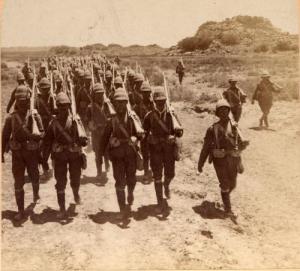
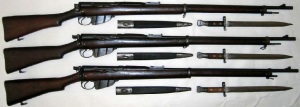


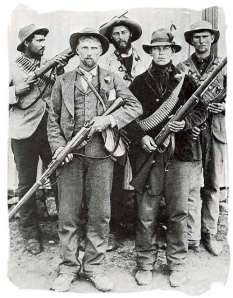
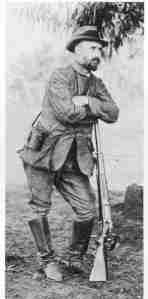
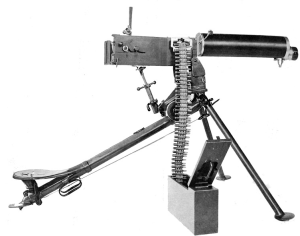
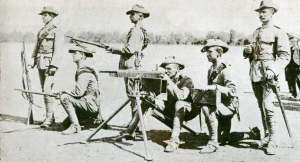
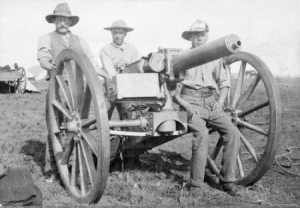
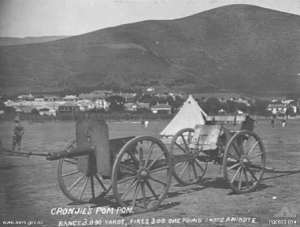


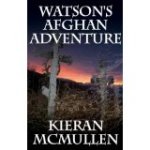

Reblogged this on Asatru / Heathen South Africa: Ramblings by Karl Andresson.
“Unfortunately that is not quite true. The Spanish American War of 1898 precedes the events of the Boer War by more than a year” THIS STATEMENT IS INCORRECT DUE TO THE FACT THAT THERE WAS A “1” BOER WAR IN 1880
You are quite correct there was an earlier Boer War. But here we are speaking of the Boer War in which Holmes and Watson participate. See “Sherlock Holmes and the Mystery of the Boer Wagon.” You must remember context as well as content.
Indeed, you need to understand context, as the Holmes connection was quite clear to most of us. Also, ALL CAP IS YELLING and besides being quite rude, most of us know the history and know there we to “wars”, so no need to shout it out like you just discovered something.
Sorry for the spelling errors, danged auto correct!
“The Mauser was a magazine fed, bolt operated rifle that, like the Enfield, used striper clips to reload the magazine.”
This is incorrect. The Lee Enfield used in the Boer War did not use stripper clips, and cartridges had to be loaded individually. This was perceived as a disadvantage compared to the Mauser, and charger loading, using stripper clips, was introduced in 1904 with the SMLE.
Earlier Lee Metfords held 8 rounds, not 10.
You are absolutely correct. The Lee-Enfields and Lee-Metfords used had the old style magazines and the new rifle, though in test by late 1900 and issued to 20 units of Royal Navy, Royal Marines, Army Cavalry and Infantry in late 1901 was not adopted officially until 23 Dec 1902. Older MLM’s and MLE’s were later retrofitted with the 1907charger bridge. I appreciate the input.
Might want to mention that many of the Boer Mausers were chambered for the 7mm Mauser, a/k/a 7x57mm. This is a different round than the more famous 8mm Mauser, used extensively by the Germans in both World Wars.
Ok, I will try this a second time, had a password issue, apologies if there is a double post. . I am writing a book on the Colt 1895 Machine Gun and later variants. I have never seen this picture an would like to use it in the book. I have the pictures of a “digger” being used in the war on the field carriage. Any folks I need to contact for a larger version and permission or credit (like this website?). I have almost all the research done, combining it with Dolf Goldsmith’s research (he has written some GREAT machine gun books) but the daunting task of putting it all together remains.
Al Sumrall
alsumrall2001@yahoo.com
Author: Battle Flags of Texans in the Confederacy, 1995
Co-Author: Old Hoodoo, The Battleship Texas, America’s First Battleship, (1895-1911)
No problem in using it. A mention of where you found it is always appreciated.
Interesting article, I would be interested to know where you found out that it was Boer Kargs that ended up in Dublin in 1916. It is unclear as to how these rifles ended up in Europe
There is a ZAR marked Krag in the possession of the National Museum.
Ex-Boer 1895 Mausers ended up in Easter Rising too … see example in Curragh Camp Military Museum which bears inscription “N B de Wett”.
Hello just wanted to give you a quick heads up. The words in
your article seem to be running off the screen in Chrome.
I’m not sure if this is a format issue or something
to do with browser compatibility but I figured I’d post to let you know.
The layout look great though! Hope you get the issue resolved soon.
Many thanks
Must have something to do with the browser. First time this has come up.
Hello! This is my first comment here so I
just wanted to give a quick shout out and say I really enjoy reading through your posts.
Can you recommend any other blogs/websites/forums
that go over the same subjects? Appreciate it!
Do we have folks out there who can help with suggestions?
The Boers Mauser rifle was not in fact a standard 1895 Mauser, but more of a modified 1893 and DID NOT have the rear safety shoulder mentioned in the article. The Chilean and other mausers did, but no Boer Mauser had that. It should be mentioned too that one of the most effective thing about the Mauser was the round. 7mm Mauser for the time had a very very flat trajectory and low recoil both of these facts made them very accurate. The British seriously considered switching to a smaller round similar to 7mm Mauser and did a lot of research into ballistics and bullets. The main thing that stopped them was World War 1 and the nightmare it would have been to switch from rounds in the middle of a war.
Thanks for your input.
First of all, smokeless gunpowder was invented by the Union during the American Civil War. Secondly, during the Boer War, the Boers used mauser rifles that were purchased from the Germans. And the Mauser rifle hand been designed and implemented in 1898.
And to top it off, my great grandfather was in the Boer War, fighting for the British. And after the Boer War, he was asked to give a list of weapons used by the Boers and the weapons used by British forces because his experience during that war was critical in determining what was needed to stop the Germans during the First World War.
First, thank you for your input. I would be very happy to have you provide your grandfathers input to the British for this site if it is still in existence, it would be very interesting to see what his experience told him was needed.
Second, you are slightly off on your facts, or at least my research has shown the following:
“Smokeless powder” or guncotton, a nitrocellulose-based propellant, was widely introduced in 1846 (at the time of the Mexican War). Guncotton was more powerful than gunpowder, but at the same time was somewhat more volatile. This made it unsuitable as a propellant for small-arms, not only was it dangerous under field conditions, but guns that could fire thousands of rounds using gunpowder would be “used up” after only a few hundred rounds with the more powerful guncotton. It was suitable for certain types of artillery however.
In 1886 Paul Vieille invented a smokeless gunpowder, called “Poudre B”, made from gelatinized guncotton mixed with ether and alcohol and was credited with such. This was useable in small-arms.
‘Mauser’ is the common name of German arms manufacturer ‘Mauser-Werke Oberndorf Waffensysteme GmbH’, (which was the successor to the original company established by Friedrick I of Wurttemberg) as well as the line of bolt action rifles they built for the German armed forces. Wilhelm and Paul Mauser worked for that company and were given complete control in 1897. Although, since 1867 the common term for the weapons they designed was “Mauser”.
In 1867 Wilhelm and Paul Mauser invented a rotating bolt system for breechloaders that was simpler and quicker to operate than systems currently in service.
In 1887 Vetterli-Vitali introduced the box magazine to rifle design, and the Germans introduced this into their own service with the Mannlicher Model 1888, better known as the 1888 Commission Rifle
In 1892 Paul designed a new extractor, the small claw that pulls the empty cartridges out of the barrel after firing, that did not rotate with the bolt and helped prevent “double feeding” of rounds from a box magazine.
The next major innovation was the ‘Model 93′, which introduced a short staggered-column box magazine holding five 7x57mm rounds flush with the bottom of the rifle, which could be quickly reloaded by pushing a strip of rounds down from the top of the open bolt
Turkey purchased the Model 93, Brazil and Sweden the ‘Model 94′. The ‘Model 95′ was very similar to the Model 93, and was sold to Mexico , Chile , Uruguay , the South African Republics (Boer Transvaal and Orange Free State ), China and Iran.
Orders for the Mauser for the Boers were delivered in 1896, 37,000 to the Transvaal and 13,000 to the Orange Free State. In 1898, with war imminent, an additional 70,000 weapons were ordered. These were the M98.
I am doing research on a very enigmatic subject, namely the ZAR’s own production of ammunition. They have manufactured artillery shells very successfully, but evidence of small arms calibers is very scarce, if not impossible to find. Anybody out there that can add to my knowledge? any link, any scanned item OR reference will be appreciated.
No reference to the Nordenfeldt multi barrel machine gun? The RN appear to have mounted them at deck level, some in turrets. Can’t find much about the gun and its variants though. Any pointers would be much appreciated.
PMP produced ammunition in the second world war. Most of it being 303, if I remember correctly. They were one of the major producers of small arms ammunition/
Knoffel
Th SA Mint manufactured ammunition in both Kimberley and Pretoria from 1938. In 1945 the Kimberley plant got closed down and the Pretoria establishment kept on with limited production. In the 60’s PMP was formed and they took over the SA Mint production.
Extremely interesting site. I recently ‘spotted’ an unnamed rifle (less bolt) inTaunton military museum, purporting to be an ex-Boer weapon. A little research on my part identified it as a Mannlicher M1890 Karbine produced for the A-H cavalry (no bayonet lug, stacking rod or hand guard) manufactured between 1890 -96. Does anyone know if these were officially purchased by the Boer state, along with the ‘new’ semi and finally fully smokeless ammunition; as it seems a very valuable and modern weapon to be in the hands of a farmer, especially as it could not have been captured from the British.
Please would you let me know where we can view the wagons used in the boer war
Wagon Museum
The Wagon Museum is situated on the same premises as the First Raadsaal Museum. It houses a collection of historical wagons and carriages, such as a spring wagon, Voortrekker ox wagon, transport wagon, stagecoach, mule wagon, spider and Cape cart.
Contact:
95 St George Street, Bloemfontein
Monday to Friday: 10:00am – 1:00pm
Saturday, Sunday and Public Holidays: 2:00pm – 5:00pm
Pingback: The Anglo-Boer War Museum – London Traveller
Thank you for a most interesting article. My great uncle fought with the British during the Second Boer war (Yeomanry). When in the Army Cadets in the early 1960s we had .303 Martini-Enfield carbines for issue to the smaller cadets for drill – we were told that these came from the Boer war (and were later issued to the Home Guard during WW2)!!!
Excellent site I will be back 🙂
Was there record keeping then? if you knew of an individual officer in the war would their issued serial numbers be on file?
I am assuming you are talking about weapons serial numbers and not service numbers. Yes, there was good record keeping. But, issues to soldiers would be done at the company, troop, or battery level. whether those records are extant I cannot tell you. Issues by the Army to regiments should still exist but that doesn’t tell you which individual soldier had the weapon. Additionally, many officers, if not most, provided their own side arms. This was not at all uncommon. Therefore weapon serial numbers would not be found.
I wonder if the Boers could have won this one. By say inflicting enough casualties the British would have called it quits. The British had overwhelming numbers so they would beat the Boers eventually. The fact that the Boers inflicted 22,000 combat casualties vs only 6,100 loses is pretty good. This points to maybe they could have upped that somehow with better strategy since their tactic were already excellent.
Pingback: The British Empire’s Holocaust Hypocrisy: The Shocking Reality Of The Second Anglo-Boer War – News For The Blind
Interesting article, whether one agrees or disagrees. Well worth the time to read.
Very interesting read both the articles and comments that followed. Great help in writing my novel set during The 2nd Boer War
Glad we could help.
Very good and interesting info on the 2nd Anglo Boer War. I had the privilege to have known one of the great war heroes because he was my godfather and I used to sit next to him and ask him to tell me about his exploits. He was Capt. Carolus Johannes Trichardt a bitter end Burger who fought with Jack Hindon under Gen. Louis Botha. He later earned an M.C. in WW1 as well as a D.C.M. He told me that the one thing that scared him during the ABWar was the Pom-pom. The British used a Vickers Maxim, while the Burgers used the Nordenfelt Maxim. These weapons used the same ammunition of 37mm.
Very interesting reading. I have in my gun room a Enfield Carbine 5 round mag. In top condition . There were, I am told only 1500 rifles, Enfield Carbine sold to New Zealand and issued To Soldiers for the Boar War.
JW
Very interesting indeed. Have you come across any references to either side (personal purchase) using Winchester 1892s? Specifically, the 1892 model in .44-40. Many thanks, Kieran Whelan.
Kieran, I know of 3 Winchesters but I havenever been able to find a reference to model or calibre. Kieran